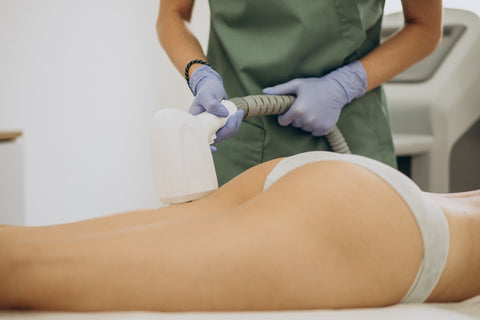Fat Freezing vs Fat Melting - Which is Right for You?
Mar 26, 2024
If you want to lose those stubborn extra pounds but can't decide between CoolSculpting (fat freezing) and Sculpsure (fat melting)? This guide will help to decide which is right for you.
Regular exercise, a good sleep pattern, and a well-balanced diet can help you stay healthy and in terrific condition.

Unfortunately, many of us have a few parts of our bodies that we are never satisfied with. And no matter how many hours we spend in the gym, the fat on our arms, belly, and knees continues to irritate us daily. Do not worry! You have other possibilities. Freeze or melt the stubborn fat.
Welcome to the leading edge of non-invasive fat reduction. If you're considering having one of these non-invasive treatments, you should be aware of the differences between them.
Understanding Fat Freezing
Fat freezing also called Cryolipolysis is a non-surgical procedure used for body sculpting and fat reduction. It involves exposing fat cells in particular body parts to extremely low temperatures for a predetermined amount of time.
How Fat Freezing Works
The fat cells under the skin are crystallized by the sub-zero temperature, which results in their cold collapse. The deceased fat cells are then eliminated by the body's natural mechanisms.
Unsightly fat bulges progressively decrease, and ideal body shapes are established.

Unlike liposuction, which may cause scars and need extended recovery times, fat-freezing methods do not harm the surrounding tissues. It is a hop-on, hop-off treatment with quick recovery durations that do not have the same hazards as previous surgical procedures. Fat freezing machine has successfully reduced fat bulges in the belly, thigh, upper arms, back, flanks, and chin.
Candidates suitable for fat-freezing treatments
Fat freezing is helpful for those who are near their target body weight but have trouble losing fat in specific places that defy diet and exercise. Good applicants have reasonable expectations and recognize that fat freezing is not a weight reduction treatment, but rather a body reshaping procedure. It is appropriate for a variety of body locations, including the abdomen, flanks, thighs, and behind the chin.
People who have severe obesity or certain medical issues, however, might not be good candidates; they should speak with a licensed healthcare professional.
Understanding Fat Melting
Opposite to fat freezing, which employs low temperatures, fat melting uses heat to remove undesirable fat. This makes more sense because we are all aware that high temperatures cause harm to living cells and tissues. Simply said, fat cells are more vulnerable to severe temperatures, both low and high, than other normal cells.
How Fat Melting Works
Fat melting employs modern technologies that use powerful lasers or radiofrequency to penetrate deep into the skin. These devices function by elevating the core temperature of fat cells, causing apoptosis, in which the cells self-destruct. Importantly, the surrounding skin is left undamaged throughout this process. Unlike invasive surgical procedures such as liposuction, fat melting does not cause physical injury or wounds to the body.
Studies have demonstrated its safety and effectiveness, with roughly 25% of fat cells eliminated from the treated region. This non-invasive method is very easy for those who want to lose weight without having surgery. Targeting hard-to-reach fat deposits, fat melting stimulates thermogenesis and treats lipidosis, making it an alluring choice for reaching body sculpting objectives.
Ideal Candidates For Fat-Melting Treatments
Ideal Candidates for fat-melting therapies should have localized regions of persistent fat that are resistant to diet and exercise. They may be close to their target body weight but still have fat pockets in the tummy, thighs, hips, or arms. Candidates should know that the therapy cannot replace total weight loss and should have reasonable expectations regarding its effects.
People who have very elastic skin typically have the best outcomes since their skin can adjust more easily to changes in body shape following fat removal. To find out if they are a good fit for fat-melting procedures, individuals should speak with a licensed healthcare professional.
During the consultation, subjects such as adipose tissue, lipolysis, cryotherapy, adipocytes, and lipids naturally arise, allowing for more educated decisions.
Key Differences Between Fat Freezing and Fat Melting
Both fat melting and fat freezing treatments use severe temperatures to kill fat cells. One warms up fat cells to achieve fat cell death, while the other uses cold/cryo to achieve fat cell death.
To make an educated decision about which is more appropriate for you, you must take into account many criteria in addition to the significant variations in treatment durations, application regions, outcomes, and possible side effects.
These considerations include your body weight and fat percentage, fitness level, problem regions, skin laxity, and pain tolerance. A thorough pre-treatment consultation with the doctor will assist in establishing the best treatment approach. For others, alternating between fat freezing and melting techniques may be preferable to obtain the greatest results that a single modality may not be able to provide.
Extra shock wave therapy and techniques to remove pressure may help to get rid of the melted fat faster, leading to quicker changes in body shape.
|
Variables |
Fat Freezing |
Fat Melting |
|
Mechanism of Action |
Cooling fat cells to trigger apoptosis (cell death) via cryolipolysis. |
Various treatments, such as laser, ultrasound, and injections, damage fat cells, resulting in their breakdown and removal. |
|
Procedure and Equipment |
Application of specialized cooling devices without surgery, using applicators or paddles. |
Uses laser devices, ultrasound equipment, or injectable remedies in outpatient settings. |
|
Treatment Sensation and Side Effects |
Initial pain from severe cold, followed by numbness, with the possibility of transient redness, bruising, or swelling. |
Variable sensations range from warmth to mild pain; transient bruising, swelling, or redness are possible side effects. |
Factors to Consider Before Choosing
Before deciding on fat freezing or fat melting operations, various variables should be considered to provide the best therapy for your specific needs.
Body Areas Suitable For Treatment
When contemplating fat freezing or fat melting, it is critical to identify the exact body locations being targeted. Both procedures efficiently remove fat in areas such as the belly, flanks, thighs, and arms. However, efficacy varies; fat freezing is best suited to broader regions, whereas fat melting may excel in smaller, more localized pockets.
Fat freezing causes hyperthermia in subcutaneous fat, resulting in lipase enzyme activity and progressive disintegration. In contrast, fat-melting technologies such as laser or ultrasound directly damage fat cells.
Cost Comparison
When picking between fat freezing and fat melting, the cost is a significant factor. Because of the particular equipment required, fat freezing is often more expensive to begin with. On the other hand, while fat melting may appear to be less expensive at first, many treatments may be required, which can add up. So, while fat melting appears to be less expensive at first, it may cost more in the long term.
Consider how using certain fat-busting medications (lipotropic drugs) and excessive cholesterol (hyperlipidemia) may be managed with the aid of fat melting. Making the greatest decision for your health and budget can be aided by being aware of these expenses and advantages.
Time Commitment and Recovery Period
Every operation has a different time commitment and recuperation time. Sessions for fat freezing usually take 30 to 60 minutes per area, with little recovery time and an instant return to regular activities. On the other hand, fat-melting procedures could require numerous sessions spaced out over a few weeks, although for shorter periods overall.
Furthermore, recuperation times may vary depending on individual reactions and the strategy employed. Fat melting relies on thermogenic effects and thermoregulation systems, but fat freezing may not. Also, some therapies, such as those involving hypodermic injections, could have varying recovery durations.
You should discuss your objectives, medical history, and any concerns you may have with a certified healthcare practitioner before making a choice. They may offer tailored advice based on your particular situation and assist you in selecting the best course of action to reach your goals.
Fat Freezing vs Fat Melting – Which Must Be Choose?
For body sculpting, it's important to weigh the non-invasiveness of fat freezing and melting against the use of severe temperatures to destroy fat cells. Both operations provide safe, efficient substitutes for invasive techniques like liposuction. Both fat melting and fat freezing work well to target stubborn fat, although some people might prefer the latter since it feels better overall and has the added advantage of tightening the skin.
Fat freezing, also known as cryolipolysis, involves chilling fat cells to cause apoptosis, which leads to their slow removal from the body. In contrast, fat melting treatments use methods such as radiofrequency or lasers to burn fat cells, causing them to break down and be naturally eliminated. Both treatments address lipodystrophy without the hazards associated with surgical procedures such as hypothermia or heat.
The decision between fat melting vs fat freezing ultimately comes down to personal preferences and objectives. Fat melting may appeal to those looking for a pleasant procedure with possible skin tightening, while fat freezing may be preferred by others because of its shown effectiveness and short recovery period. Making well-informed decisions based on their particular requirements can be facilitated by speaking with a licensed healthcare professional.
Conclusion
Finally, while deciding between fat freezing and fat melting for body sculpting, consider your preferences and goals. Both provide safe alternatives to intrusive treatments while efficiently addressing stubborn fat. Fat freezing causes apoptosis by chilling fat cells, whereas fat melting causes them to break down through heat. The decision is based on desired results, tolerance for treatment symptoms, and recuperation preferences. Consulting with a healthcare professional guarantees that you receive tailored assistance for the best possible results.

